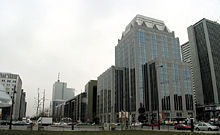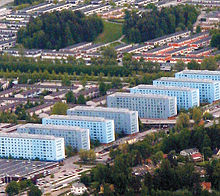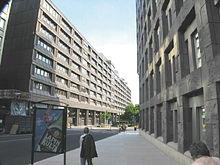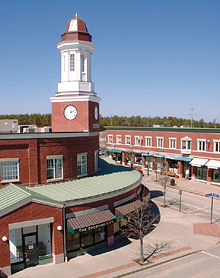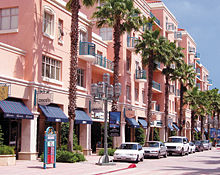
COUNCIL REPORT V -- OCTOBER 2003
Shop and Awe: The Peril of American-Style Commercial Development for Europe
Note: This essay appears in the "Council Report
V," which contains a wealth of additional material on European urbanism,
profiles of European projects, and American perspectives. Click
here for more information, or download the order
form.
This essay grew out of the rich exchanges I enjoyed with Europeans at
both the first EuroCouncil in Belgium in April 2003 and during a series
of presentations I made in Stockholm, Sweden, at the "City Streets, Main
Streets and Meeting Places" conference sponsored by the Urban City Research
Ax:son Johnsonstiftelsen Foundation in Stockholm, Sweden, in June 2003.
In April, when I was invited to speak on the new town centers and main
streets being built in the United States and Canada at the EuroCouncil,
I was at once excited and anxious. The explosion of development involving
pedestrian-oriented main streets and town centers in American suburbs,
edge cities and low-density urban areas has been one of the most promising
anti-sprawl trends of the past decade. In the United States, where over
half the population resides in suburbs, and where large portions of our
metropolitan cities are composed of low-density, single-use, automobile-oriented
development, the emergence of mixed-use, pedestrian-oriented town centers
has been nothing short of an epiphany. For all the excitement these projects
have generated in the United States, however, they are pale shadows of
the urban centers of historic towns and cities in the United States and
Europe. What could our nascent efforts to build town centers possibly
teach Europeans? The answer, as it turned out, was that the United States
has much to teach Europe.
During the opening sessions in the historic section of Brussels and the
extraordinary medieval town of Bruges I listened attentively to presenters
from throughout Europe. Several things became clear that revealed how
important it is for Europeans to pause and take a long, hard look at the
American experience and consider the devastating impact that laissez-faire
commercial sprawl would have on European metropolitan landscapes and the
European way of life.
|
|
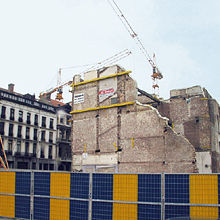 Demolition of historic residences, Brussels, 2003 |
|
|
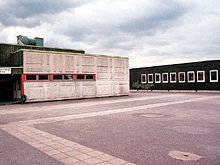 Slab-urbs: the pedestrian's view |
First, the classic European town centers, market squares,
piazzas and high streets Europeans prize and Americans flock to each year
have not been models for new development in Europe for a very long time.
The slab-urbs, modernist new towns, spread of single-use, monofunctional,
car-dominated development, and the host development issues documented
in the CEU Charter reveal the extent to which European development patterns
have departed from the traditional European city over the past six decades.
Second, while the pattern of new development in Europe has long been sub-urban
in character, long-held policies aimed at protecting the integrity of
historic town centers and high streets have gradually been relaxed and,
in some cases, removed for periods of time, allowing for the rapid introduction
of big box retailers and out-of-town shopping centres that have begun
to echo the path of destruction that occurred in America.
The relaxation of retail policy in Britain produced an outcry from shopkeepers,
elected officials and residents of historic towns and cities damaged by
out-of-town competition. This led to a number of important policy papers
and texts including Urban Villages (1992), published by the Urban Villages
Group, and the UK Department of Environment's Vital and Viable Town Centres:
Meeting the Challenge (1994). U.S.-style commercial development has made
significant inroads in the United Kingdom and much of mainland Europe,
and has come to dominate new commercial development in Scandinavian nations.
Third, the examples of new urban European development presented at the
Council revealed that the lingering self-consciousness and discomfort
with traditional architectural style was leading to neglect of basic features
of traditional building types. The typology of traditional buildings embodies
timeless elements of storefront design and frontages that define urban
retail streets and accommodate the convivial marketplace. As the CNU Charter
states, such issues "transcend style."
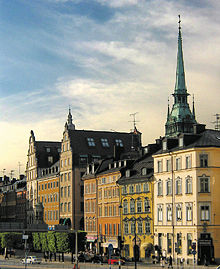 Historic Stockholm |
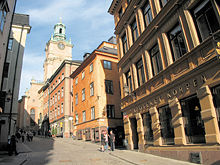 Historic Stockholm: street-level perspective |
|
|
|
Along with these warning signs is the knowledge Americans
have gleaned in doing battle with commercial sprawl over the past two
decades and through the modest successes we have enjoyed in reintroducing
the possibility of pedestrian-oriented, mixed-use town centers.
(1)
The lesson from America begins and ends with a warning: Conventional suburban
retail formats that constitute a major portion of sprawl in the United
States represent a voracious virus that, once introduced into the European
fabric, will rend it and eviscerate the small scale, high-service shopkeepers
that have been a cornerstone of European social and cultural life for
ages. A recent article on the rapid decline of small shops in Italy captured
the "shop and awe" impact of American-style supermarkets:
"The number of supermarkets has surged 74 percent, from 3,696 in
1996 to 6,413 in 2000, says Confcommercio, an Italian business lobby.
In the decade through 2001, the number of small food shops slumped 24
percent, from roughly 254,000 to 193,000, said Confesercenti, a small
businesses lobby."(2)
Europeans need to look at the devastation, waste and placelessness of
retail sprawl that has swept across the American landscape. American real
estate development has refined highly successful freestanding retail formats
including: gas station/food marts; drive-through fast food restaurants,
banks, liquor stores, and even espresso "cafes"; larger formats that dominate
retail trade including neighborhood- and community-scale shopping centers,
regional and super-regional shopping malls, factory outlets, and power
centers anchored by big box discount stores; and new formats that continue
to assimilate competitors and morph into pseudo-urban settings including
lifestyle centers, urban entertainment centers and shopping malls attached
to retail-only "main streets." All of these retail formats represent "machines
for shopping": single-use pods, disconnected from residential neighborhoods
and the larger community.
While American consumers have enjoyed an extremely wide variety of goods
at competitive prices, these benefits have come at a cost, which Europeans
must now decide if they are willing to pay.
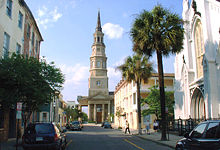 Historic Charleston, S.C. |
The first and most damaging cost was the near obliteration
of America's historic main streets, town centers and downtown shopping
districts. In the United States there were no policies enacted to protect
existing downtowns and business owners from out-of-town competition. In
fact, the destruction of town centers in the United States was subsidized
by massive investments in interstate highways and bypasses that opened
up millions of acres of land for development and literally redirected
traffic around, rather than through, historic downtowns. With this destruction
came other costs, such as the decline and failure of downtown businesses
including the types of small shops and family-run businesses that Europe
still enjoys. The final cost is that communities become littered with
carcasses of dead retail properties. In the United States a relentless
and ever-accelerating cycle of retail Darwinism has been created, one
that has witnessed dramatic consolidation of business across market sectors
including department stores, grocery stores, drug stores, book stores
and home improvement stores.
In 1986, the top three discount department stores accounted for 61 percent
of sales in their market segment; a decade later in 1996, they had 85
percent. By 1997, they had 87 percent, according to the International
Council of Shopping Centers, a trade group.
It is much the same with drugstores, conventional department stores, and
home improvement stores. In the consumer electronics industry, the top
three firms had 15 percent of sales in 1986 and 31 percent by 1996. For
just those three retailers, annual sales growth averaged 17 percent a
year during that time; all others in the business had an overall growth
rate of less than 2 percent.(3)
Research by the National Trust for Historic Preservation and Kenneth E.
Stone in the United States has shown that replacement of small local and
regional businesses with national chains results in more of a community's
buying power leaving the local economy, as profits pass from chain store
to corporate headquarters located in other cities, states and increasingly
in other nations.(4) Profits from the locally owned independent store,
in contrast, remains largely within the local economy. This is consistent
with Jane Jacobs' writing in "The Economy of Cities" and the importance
of import substitution for sustaining and rebuilding local economies.
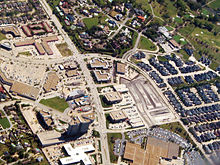 Aerial view of typical United States sprawl reveals the rigid segregation of land uses. |
The planned obsolescence of new retail construction
is equally astonishing. During a trip to Starksville, Miss., I was driven
along the out-of-town commercial strip where we passed by three generations
of WalMart stores built within 20 years of one another. Starksville, like
hundreds of other U.S. towns and cities, has a retail archeology of hundreds
of empty retail stores, strip shopping centers and shopping malls that
resulted when larger stores and more specialized retailing formats were
built further and further from the city. The decline of America's early
suburbs is intertwined with the retail wreckage along these arterials
and highways and is not limited to older suburban areas. In Memphis, Tenn.,
the ongoing construction of an outer loop highway has taken the disposable
nature of sprawl development patterns to a new level, leading to the precipitous
decline of a suburban area built in the 1980s. As 50 years of experimentation
in the United States has proven, the American real estate industry has
become very good at building specialized residential, office and retail
projects, but the projects themselves are not very good at building communities.
|
|
There are many in Europe who will point to the commercial
success of American-style development, gush about the extraordinary efficiency
of the delivery system for chains like WalMart, where large percentages
of its inventory are on America's highways en route to consumers rather
than sitting in warehouses, and argue that American formulas for commercial
development must be adopted wholesale in Europe. They would do well to
heed the warnings presented here, and to consider the dilemma in which
we currently find ourselves.
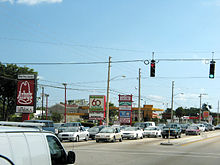 Are Europeans prepared to trade cheap goods in exchange for replacing the European way of life with the American way of life? |
In 1995, a survey of suburban homebuyers conducted by
the American LIVES group found that a remarkable 86 percent of respondents
stated a preference for mixed-use, pedestrian-oriented town centers with
buildings clustered around a village green, and that only 29 percent favored
the status quo consisting of shopping and civic buildings distributed
along commercial strips and in malls. Despite the fact that an overwhelming
majority of Americans now actually prefer the traditional town center,
the forces of finance, specialized real estate practices, standardized
retail formats, and outdated public policy continue to induce sprawl and
conspire against urbanism, and the work to redevelop the continent-wide
morass of commercial sprawl will take several lifetimes to realize. The
way back from the brink is long and hard.
This is the final warning from America and reveals just how daunting it
becomes to undo the damage wrought by large-scale retail chains and disposable
commercial properties. Even our new town centers and main streets that
strive to adopt traditional urbanism are largely populated by the same
chain stores and restaurants that populate strip centers, shopping malls
and "out parcels" in sprawl. Quality of life is not equivalent to cost
of living, and the value of savings wrought from purchases of jumbo rolls
of toilet paper at WalMart is not a perfect substitute for the social
use value or the employment and community reinvestment value of corner
stores and family-owned and run businesses. Cashing in the European way
of life for cheaper underwear and 57 varieties of toothpaste instead of
12 is a myopic exchange and cuts to the heart of European apprehensions
over the Americanization of their economies and cultures.
I do a presentation titled "The Second Coming of the American Town Center."
For the EuroCouncil I reinterpreted this as "The Second Coming of the
Market Place," for this is what European urbanists must bring about with
respect to changes in retail practices that are already upon them. It
is not a question of turning back the clock; the genie is out of the bottle
and Europeans will continue to demand opportunities to purchase lower
cost goods and services. It is also likely that development on the outskirts
of European cities will continue as the need for housing increases development
pressures. This article, and most that discuss town centers, puts an emphasis
on retail, but the way back from commercial sprawl involves confronting
each piece of single-use sprawl -- residential, office, retail, hotel,
civic, light industry -- and reassembling portions of this in the form
of traditional neighborhoods, town centers, high streets and market places.
To protect European town centers, market places and high streets at all
costs, the United States offers pragmatic, hard-earned knowledge on how
to begin reconciling the demands of modern retailing and large-scale commercial,
office and residential development with the practice of urban place making.
My book "Place Making" (Urban Land Institute, 2002) chronicles the first
attempts to reconcile these opposing forces in the United States; I included
several examples of this in my presentation at the EuroCouncil.
U.S. developers and designers have advanced rapidly to develop urban design
and real estate strategies that adapt large-scale retail, office and residential
uses to more urban formats. This has involved countless challenges to
conventional practices and beliefs concerning parking, highway access
and visibility, market acceptance of urban residential and office types,
reconfiguration of big boxes to provide a street-orientation, and entrenched
finance, development and management practices in a pure market-based system.
Turning these conventional models around has been an impressive accomplishment
and one that can inform the European struggles to adapt the now pervasive
moves to introduce American-style commercial development.
Americans, on the other hand, still have much to learn
from their European counterparts with respect to architecture, especially
in cases involving the urban core. I highlighted the weak architecture
of many U.S. town center projects during my EuroCouncil presentation.
In the United States, the struggle to move from the low level of design
skill and investment required for a conventional strip mall facade to
those capable of creating a respectable urban retail architecture has
been daunting and very much a matter of dollars over design. Without any
assurance that a pedestrian-oriented, mixed-use format would succeed,
developers were loathe to lavish money on architecture, and still decry
what they consider excessive premiums paid for the architecture and design
of new town centers. Within the short-term investment time frame of most
U.S. developers, these are costs that can only be justified through greater
public subsidy of town centers (something much more unusual in the United
States than in Europe) or evidence of higher profits to developers (something
yet to be established).
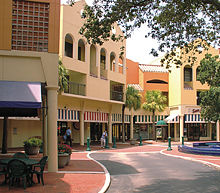 Miami Lakes, Fla. (1983) |
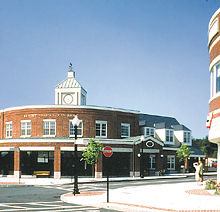 Mashpee Commons, Mass. (1986) |
|
|
|
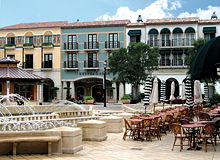 City Place, Fla (1998) |
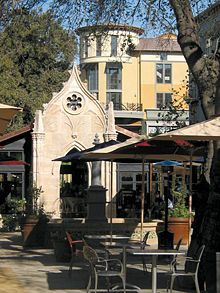 Santana Row, Calif. (2000) |
There is reason for hope, however, as a quick chronological
survey of United States town center projects built since the mid-1980s
reveals some dramatic and very obvious improvements in their architecture
as each new project has raised the standard for those that follow. As
the general quality of architecture in U.S. projects improves, the lingering
issue for Europeans will concern architectural style. (See sidebar, "The
'Oppressive' Design of Southlake Town Square's Town Hall").
In the United States we are just beginning to rediscover the possibilities
for creating complex, civic-oriented, human scale market places. Some
of our greatest inspiration comes from the historic market places and
high streets of Europe. The new U.S. town centers pale in comparison to
these great historic urban settings, but their stature grows when placed
alongside Europe's slab-urbs, town centers of new towns, and contemporary
Eurosprawl.
In time the new U.S. town centers may evolve into richer,
more complex urban places, but here, at the time of their birth, they
are urban fragments (perhaps seeds) in a sea of sprawl. But each one also
represents a real world learning experience in how to reconcile the age
of the automobile, large scale retailing and other specialized development,
and the realities of 21st century real estate finance and development
practices. To that end they are experiments extremely worthy of further
study on both sides of the Atlantic.
1. The term "Shop and Awe" is a reference to the "Shock and Awe" tagline
given to the US assault on Iraq. The assault occurred in March 2003, one
week before the EuroCouncil in Belgium took place.
2. "Italians Bid Arrivederci To Mom-And-Pop Grocers," Los Angeles Times,
February 16, 2003.
3. "Retailers Making Big Plans Despite Warning Signs," The Record
(Bergen County, N.J.), May 16, 1999.
4. Stone, Kenneth E., "Impact of Wal-Mart Stores and other Mass Merchandisers
in Iowa, 1983-1993," Economic Development Review, Spring, 1995.
Charles C. Bohl is a research associate professor and director of the Knight Program in Community Building, a program associated with the University of Miami School of Architecture. He has taught planning and urban design at UNC-Chapel Hill and NCSU School of Design. Bohl is author of "Placemaking: Town Centers, Main Streets and Transit Villages."
